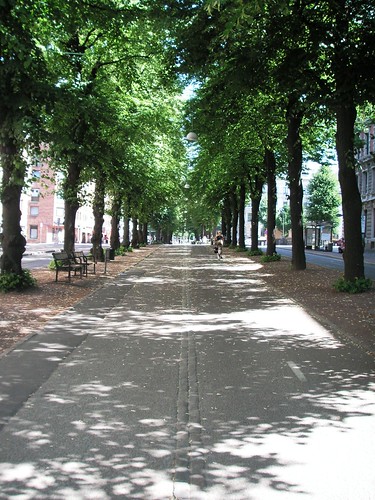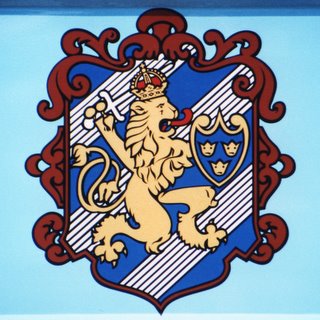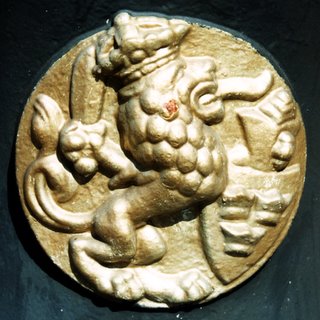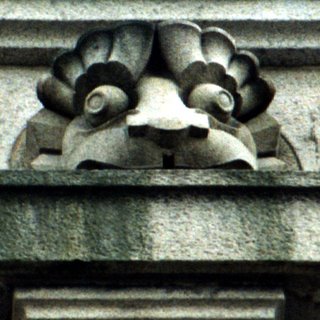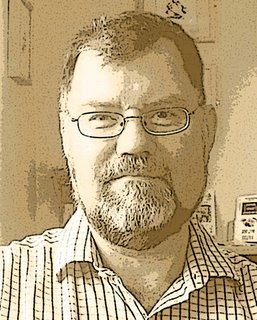One Week's Blog (23-30 July)
Old Älvsborg and the Carnegie Brewery
(Sunday 23rd July) Today I made a small photo study of the old Carnegie porter brewery at Klippan. Actually I was trying to find my way to the ruins of the original Älvsborg – the fortress which once guarded the Swedish possessions on the river (älv), and which was captured by the Danes and ransomed, not once but twice, in 1570 and 1613. The second ransom, paid between 1613 and 1619, was set at 1 million silver dollars, equivalent to 25 000 kilos of silver. It was after this that the present city of Gothenburg was founded, and is the reason the city was built not only as a trading centre but also as what was for many years the most well-defended city in northern Europe. As part of the defences, Älvsborg was moved out to an island in the river, and the old fortress fell into disuse. Now it lies in overgrown ruins, protected by a few sheets of corrugated iron and surrounded by the bulk of the brewery which grew up on the site many years later. Times change, and even the brewery has passed on. A huge amount of demolition and rebuilding is going on around the site, and I wasn’t able to find my way in to the ruins of the fortress, but I was able to take some pictures from a distance. Instead, I wandered around the buildings of the brewery which are being used for all sorts of small enterprises. The brewery started life as a sugar refinery, founded by a German immigrant in 1808, but in 1836 it was taken over by the Scottish entrepreneur, David Carnegie. For more than 100 years, it supplied the beer, and especially the porter, with which the growing numbers of industrial workers in Gothenburg and the rest of Sweden slaked their thirst after hard days in shipyards, foundries and mines.
Screaming in frustration
(Monday 24th July) Today I uploaded my first 'blog of the week' (just after midnight – having spent most of Sunday evening writing it). I also wrote and uploaded my first 'Progress Report'. Generally I was feeling very happy with myself and the progress I was making. Then I spent hours composing, cropping and formatting illustrations in order to upload them to Blogger, as I had done at the beginning of the previous week in the week for the 'Introduction' and 'The Story So Far'. It didn’t work. And it kept on not working: I couldn’t believe it, and was convinced I must be doing something wrong, but no matter what I tried, I had no joy. I started to read the FAQs and realised I wasn’t alone in having just this problem. There are plenty of suggestions for 'work arounds', but it all takes so much time and I really don’t want to spend hours of my life trying to pick my way through this solution or that, trying to edit HTML I only half understand. I end up screaming blasphemies at the computer, the Internet, Blogger …
Off day
(Tuesday 25th July) Spent another miserable day failing to make Blogger work, setting up an account with Flickr, failing to make Flickr and Blogger co-operate. By mid-afternoon I’m no longer screaming with frustration. Instead I’m working myself down into a depression, calculating all the time spent – read wasted – on this project. Thinking about all the work I’ll have to put in to my new teaching year (starting 14th August). This project’s 6-8 month time span is a joke. In the afternoon, because she felt sorry for me, my public persuaded me to meet her from work and go to the fun fair at Liseberg. We went to see the young (nowadays, I suppose, youngish) Gothenburg magician, Carl-Einer Häckner, who has become an institution on Liseberg’s open-air stage. This was the 10th year of his summer variety show and he did a series of clips from his previous shows. Most appreciated (by the younger members of the audience), was the blood and guts magic (cutting off his ear, mangling his thumb, sawing off his arm). His showmanship is inspired by Tommy Cooper, but he enjoys performing in the context of a story. I don’t think this comes across so well on the big open-air stage. He also enjoys singing sentimental songs which I can do without. Nobody in the audience seemed agree with me on either point, though. The place was packed, even under a blazing sun. Apart from Häckner there was a German Buster Keaton-inspired acrobat-cum-mime, who was rather good, and a couple of English roller-skate performers who were boring: Round and round and round and how many ways can the fat man hold the thin woman so she flies out as he spins? Still depressed after the show. Beer and crisps and chocolate do not help.
Day off
(Wednesday 26th July) I wrote up 'Dreaming' and published it, feeling much more stable. After this, I decided to take the rest of the day off from the project.
Tales the toad told
(Thursday 27th July) In the afternoon to town for the Paddan tour. Paddan is Swedish for toad, and the Paddan boats are sightseeing boats – low, flat, broad motorised barges – which give a 'toad’s eye view' (quote from their ad) of the town. I’ve done this trip before, long ago, but I remember it as more interesting. Perhaps it’s just that I know more about the town now, perhaps I am more critical after having taught history intensively for five years. I make a list of 'Tales the Toad Told' – half-truths and disinformation – for future analysis. The sun beats down and though there is some respite on the water, by the time the trip comes to an end, the only thing I want to do is get under the shade of some trees and drink water. In the park, dozens of men and women, dressed in wool, linen and leather (skirts, britches, waistcoats, blouses), are walking around, dancing or playing instruments. What was that about mad dogs and Englishmen?
Practical problems melt away ...
(Friday 28th July) After looking again at Flickr’s instructions and making some adjustments, Hallelujah! The photos work. Spent the morning uploading pictures and getting them to show where I wanted them in the blog. I met Martin for lunch. Martin is one of my sounding boards for this project. When he isn’t sounding, he’s hounding me to get on with it … Whenever I speculate about doing something, Martin wants to know when I’m going to do it. Publish a draft of the first chapter as a PDF file? Sure, when? Record it as an MP3 file? When will that be available? Martin is very optimistic on my behalf – in discussion, practical problems melt away. I come away from the meeting feeling even more buoyed up than I felt this morning – it’s only on the way home I remember about the Blogger/Flicker photo frustration.
In the park
(Saturday 29th July) The heat continues. We take a long,but necessarily slow walk in Hisingspark photographing lillies and ferns, and pass S.A. Hedlund’s Guest Book. Once upon a time, S.A. Hedlund, the proprietor of a Gothenburg newspaper, used to have a summer residence here. Then, it was a boat across the river and a carriage ride from there, well out of town. Now it’s about ten minutes on the bus from the city centre. Part of the Hedlund estate is built over with four storey blocks of flats, part has been amalgamated into a larger area of greenery with a series of small lakes, rocky hills and woods, Hisingspark. Hedlund was a man whose interests and profession coincided so that he enjoyed the company of the famous men and women of his day. Literary lions such as Ibsen, explorers like Nansen and Sven Hedén, writers and feminists such as Ellen Key and Frederika Bremen, all visited his summer residence. Their visits are commemorated in the guest book: on the surface of a granite cliff face near what used to be the entrance to the estate, the names of all Hedlund’s famous visitors are recorded, carved into the rock and picked out with yellow paint. (In Hedlund’s day it was gold leaf.) There are about 70 names, but only one of them looks as if it might be British. In fact, W. W. Thomas Jr. was an American – one of Abraham Lincoln’s Civil War consuls. Later, he served as the US Ambassador in Stockholm and wrote a massive book – Sweden and the Swedes – at least a third of which is taken up with his hunting, shooting and fishing expeditions. He seemed to have been determined to kill at least one example of every form of Swedish wild life. I think he’s included in Hedlund’s guest book more for his translations to English of the poems and journalism of Viktor Rydberg, Hedlund’s protégé and employee.
(On second thoughts, I suppose Ellen Key’s name could be taken for English, but she wasn't. According to the Swedish Wikipedia, her family are distantly related to the Scottish MacKeys).
Another year older
(Sunday 30th July) My birthday. Let us draw a veil over this. I end the day sitting on the balcony in the cool of the evening, re-reading Coasting.










